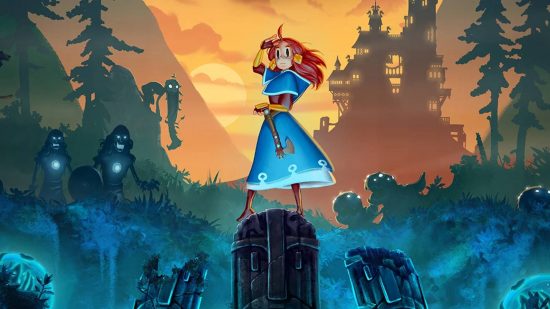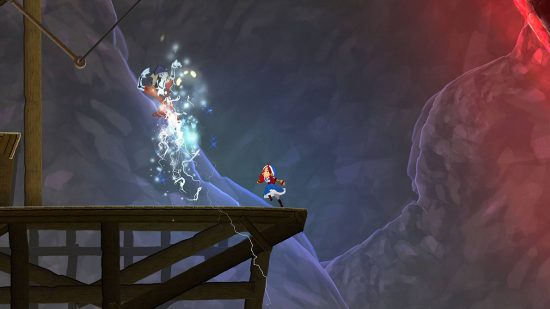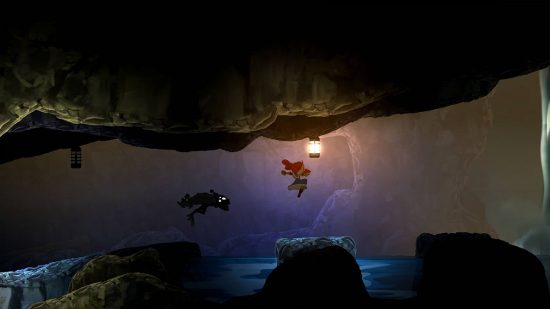Since its original release in 2013, Teslagrad holds up as an inventive puzzle platformer that uses magnets to create its predicaments. Slow, methodical, but full of eureka moments, the indie darling still maintains a cult following many years on.
So, after a decade, we now arrive at Teslagrad 2, an interesting and iterative sequel that builds upon what came before. This time you play as the young Teslamancer Lumina, who’s on a mission to get home. She has the ability to use magnetic energy to stick to metal or propel herself away from opposing magnetic forces, while she can also use electricity to zap forward, known as a blink. That’s not all there is, but that’s all you need to know for now.
The story here is thin at best, wordlessly acted around Lumina, as a vague plot involving Vikings sees her on a mission to get home. This time around though, while Teslagrad is about solving puzzles, Teslagrad 2 is much more about platforming. Sure, there are still conundrums in each room that you can only solve with your magnetic power, but everything feels more focused on movement this time around.
The gameplay in Teslagrad 2 is frantic, with big puzzles that take up a lot of space. There’s also a real feeling of speed, as you careen around large loops and slide down slopes, often using momentum and magnets to reach new platforms. This title is loosely a Metroidvania, as you revisit older areas as you progress, but it feels much more vague and expansive than most, instead of revolving around a tight focus.
As you start, you find a selection of familiar puzzles that require you to use magnetic power to stick to surfaces and blink through gates or fences to reach new areas. Occasionally an enemy or a boss fight gets in the way, but these are often dealt with by running away or throwing a projectile of some sort. Lumina is not often actively capable of attacking.
An early boss fight involving a moose is a good example of this system working well, but I often find it frustrating when I should be finding it satisfying. Enemies swarm around you, and with only the ability to blink – which demands a short recharge time – combat feels like you are just trying to stay alive. The game feels much better when Lumina has a chance to exact some real revenge on foes.
You don’t need to worry too much about bosses or enemies slowing down progression though, as almost all of the gameplay revolves around you using your magnet powers to reach new areas, avoiding enemies, and using your momentum. If anything, it reminds me somewhat of Ori and the Blind Forest mixed with Sonic – and yes, I do mean the Hedgehog.
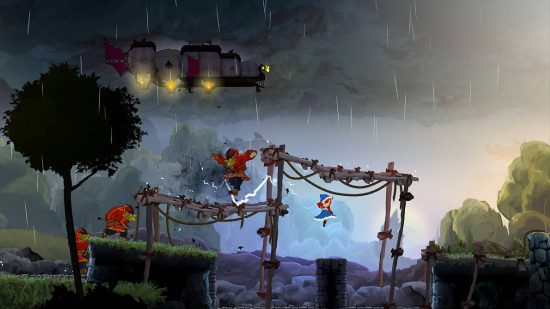
One of the crucial abilities you unlock is the power to slide and use electricity to break through things. This, coupled with your magnet power, sees Lumina hurtling through levels that fling her around like a pinball. Alongside huge magnetic worm-like waves, there’s such a strong focus on speed and momentum, it feels very at odds with the idea of a Metroidvania. It’s still fun when it works, but I can’t say that I enjoy returning to early areas that restrict your movement more.
A really fun way of moving around involves using ropes and gliding through them with electricity, much like in Super Mario Odyssey. The main way of opening up new areas is by firing ropes back into previous locales, allowing Lumina to quickly glide along them and pick up previous collectables. Teslagrad 2 feels much better when you’re enjoying the earlier sense of momentum, and I do love the huge ropes that connect different areas as a way of traversal.
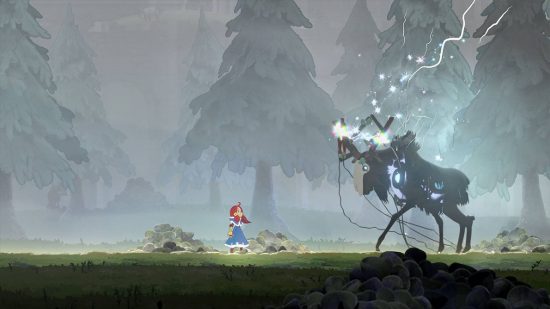
In terms of difficulty, the game is tough, and while there is an option for a casual or a normal mode, there’s no way to change this once you start. So, if you get stuck on a boss fight later, sadly you can’t knock the difficulty down, meaning you’re just going to have to stick it out. In fact, there are very few options, as you can only adjust the volume of the music or sound effects, or turn off rumble. I hope future updates can give players more ways to finetune their experience.
Speaking of music, the audio presentation in Teslagrad 2 is stellar. I love the evocative and energetic score, which definitely pulls from the Nordic influences. Also, sound effects all have a satisfying buzz, zap, or ‘thhhwwwuung’ to them when using the different abilities. Everything sounds pleasing and feels great to interact with.
Visually, things are interesting, as Lumina moves at a slow framerate, looking like stop motion against a much more fluid background. The game utilises a nice illustrative style with clear colours, and I especially like the detail and depth in the backgrounds. It’s a little simple, but there’s nothing wrong with any of it. Sadly though, the Switch struggles occasionally, as I frequently come across stuttering and framerate dips.
With a game so focused on speed and quick puzzle-solving platforming, it’s frustrating to see the performance occasionally get in the way. Mercifully, there is auto-save, and the game never drops you back too far from where you die, but it’s annoying all the same. While the game is lovely to look at, it’s still nothing too taxing. The Switch’s inability to run it smoothly is another indictment of the ageing hardware, and I don’t blame studios who know an indie title still sells best on the platform.

Altogether, Teslagrad 2 is a fun sequel that feels like a smart step for the franchise. Imbuing the magnet powers with more speed, energy, and a slightly looser feel, there’s much less of a focus on puzzles this time around. The game does lose some of its personality in the process, and, while I like Teslagrad 2, there is very little I love. There are some great ideas and Lumina feels fantastic to control, I just wish it had a better idea of what to do with her powers.
If you need even more content on the latest games, be sure to check out our guides covering Honkai Star Rail tier list and our Honkai Star Rail codes.
Teslagrad 2 review
Teslagrad 2 is an iterative sequel that brings some smart new ideas to the table. Its stronger focus on speed, momentum, and platforming feels great, but it comes at the cost of more confined puzzles and often feels looser than I’d like. Still, the movement, presentation, and great use of Lumina’s powers make this another solid entry in the series.
